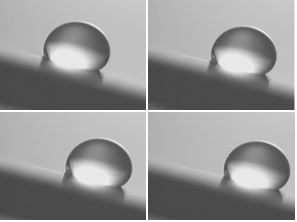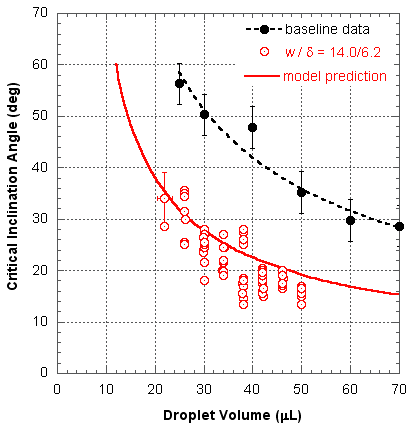Surface Wettability Manipulation
My current research focuses on the observed anisotropic wetting characteristics of micropatterned aluminum surfaces with the aim of exploiting these characteristics for the purpose of reducing water retention on heat transfer surfaces. Thus far, I have focused my attention on a specific class of surface features that are generally tens of microns in width and depth. Reductions of more than 50% have been observed in the critical inclination angle for sliding on these surfaces- a phenomenon that primarily results from the discontinuities of the three-phase contact line created by the underlying microstructure and the highly elongated, parallel-sided shape of water droplets that form on these surfaces. Standard photolithographic techniques and inductively-coupled plasma reactive ion etching (ICP RIE) were used to fabricate these surfaces with a high degree of precision.

droplet at the critical condition (i.e. point of
incipient motion) on a micro-etched surface.
Note the small angle of inclination necessary
for sliding.
in contact angles > 150 deg are termed
"super-hydrophobic."

a micro-grooved surface with a nominal channel
width and depth of 15 um. Notice the
parallel-sided base contour shape of the
droplet.
necessary for sliding versus droplet volume
for the baseline surface (shown in black)
and a micro-etched surface (shown in red).
A new mechanistic model that was developed
for predicting the critical droplet size is also
shown (red line) and predicts the data well.

The objective of this project is to determine the effect of very dilute concentrations of nanoparticles on the single-phase heat transfer of water/ethylene glycol mixtures at low operating temperatures. An experimental apparatus will be built and experiments performed to test the hypothesis that the documented enhancement in thermal conductivity reported in the literature will still be manifest at low fluid temperatures, and that the increased thermal conductivity of the nanofluid will result in increases in the tube-side convective heat transfer coefficient. Experiments will be conducted in a conventional single-phase, one-pass test system with and without nanoparticle seeding. Various nanoparticles will be considered-Cu, CuO, Al2O3 and possibly carbon nanotube particles. The significance of particle hold-up in the test section will also be determined-at a first-cut level.

(Left) This figure taken from Wang and
Mujumdar (2007) shows the thermal
conductivity enhancement ratio of various
nanofluids as a function of nanoparticle
volume fraction.
(Right) Transmission electron microscope
(TEM) image of a Al2O3/water nanofluid
(0.06% vol conc)

"Research is what I'm doing when I don't know what I'm doing."
-- Werner von Braun
"The naked intellect is an extraordinarily inaccurate instrument."
-- Madeleine L'Engle, American author
"Even the smallest victory is never to be taken for granted. Each victory must be applauded, because it is so easy not to battle at all, to just accept and call that acceptance inevitable."
-- Audre Lorde, American poet and writer